Pieter Abbeel
UC Berkeley
Responsive Safety in Reinforcement Learning by PID Lagrangian Methods
Jul 08, 2020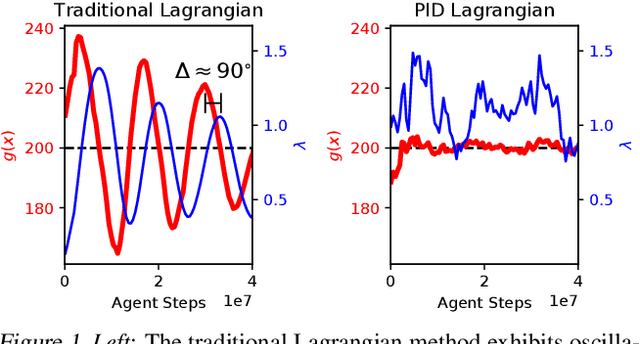
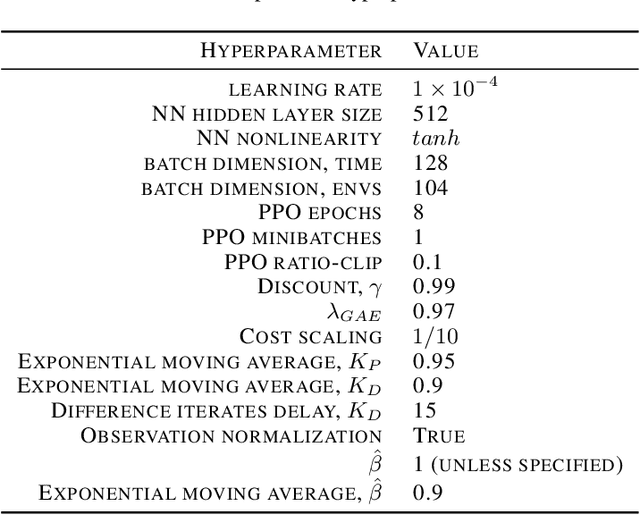
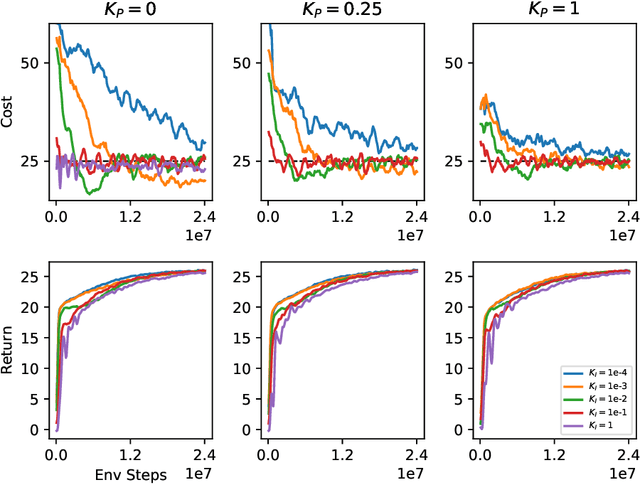
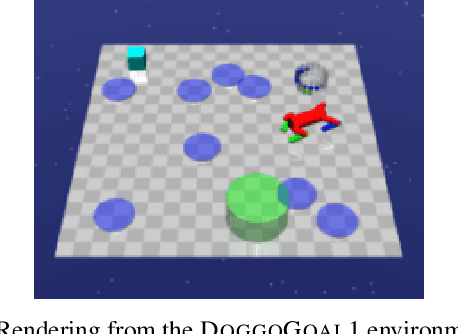
Abstract:Lagrangian methods are widely used algorithms for constrained optimization problems, but their learning dynamics exhibit oscillations and overshoot which, when applied to safe reinforcement learning, leads to constraint-violating behavior during agent training. We address this shortcoming by proposing a novel Lagrange multiplier update method that utilizes derivatives of the constraint function. We take a controls perspective, wherein the traditional Lagrange multiplier update behaves as \emph{integral} control; our terms introduce \emph{proportional} and \emph{derivative} control, achieving favorable learning dynamics through damping and predictive measures. We apply our PID Lagrangian methods in deep RL, setting a new state of the art in Safety Gym, a safe RL benchmark. Lastly, we introduce a new method to ease controller tuning by providing invariance to the relative numerical scales of reward and cost. Our extensive experiments demonstrate improved performance and hyperparameter robustness, while our algorithms remain nearly as simple to derive and implement as the traditional Lagrangian approach.
Locally Masked Convolution for Autoregressive Models
Jun 27, 2020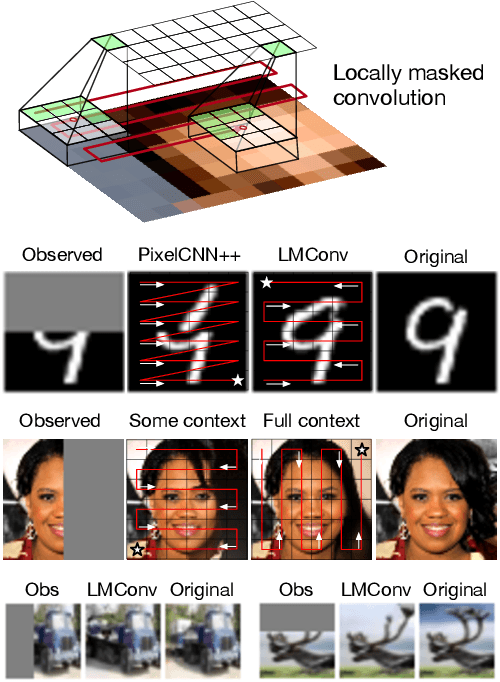
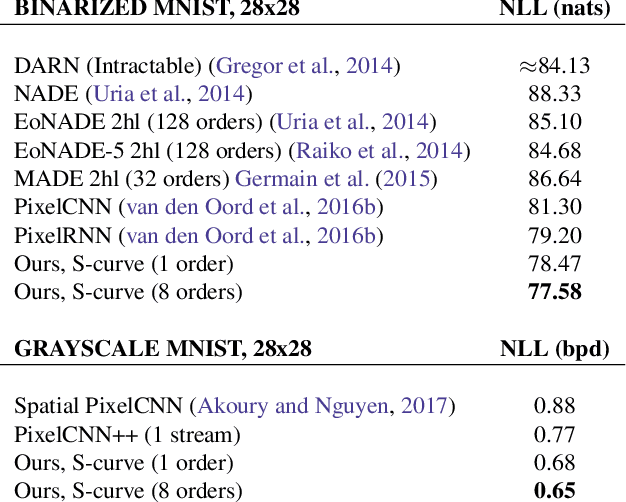
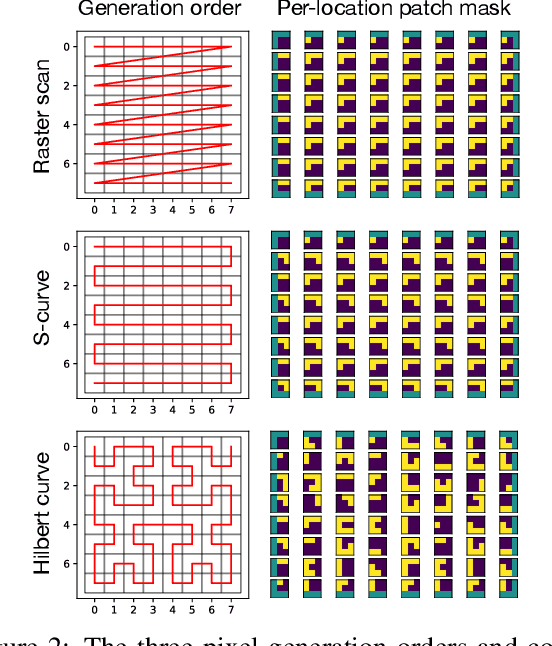
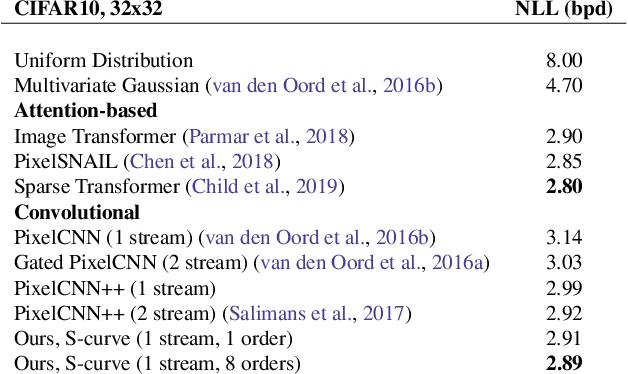
Abstract:High-dimensional generative models have many applications including image compression, multimedia generation, anomaly detection and data completion. State-of-the-art estimators for natural images are autoregressive, decomposing the joint distribution over pixels into a product of conditionals parameterized by a deep neural network, e.g. a convolutional neural network such as the PixelCNN. However, PixelCNNs only model a single decomposition of the joint, and only a single generation order is efficient. For tasks such as image completion, these models are unable to use much of the observed context. To generate data in arbitrary orders, we introduce LMConv: a simple modification to the standard 2D convolution that allows arbitrary masks to be applied to the weights at each location in the image. Using LMConv, we learn an ensemble of distribution estimators that share parameters but differ in generation order, achieving improved performance on whole-image density estimation (2.89 bpd on unconditional CIFAR10), as well as globally coherent image completions. Our code is available at https://ajayjain.github.io/lmconv.
Denoising Diffusion Probabilistic Models
Jun 19, 2020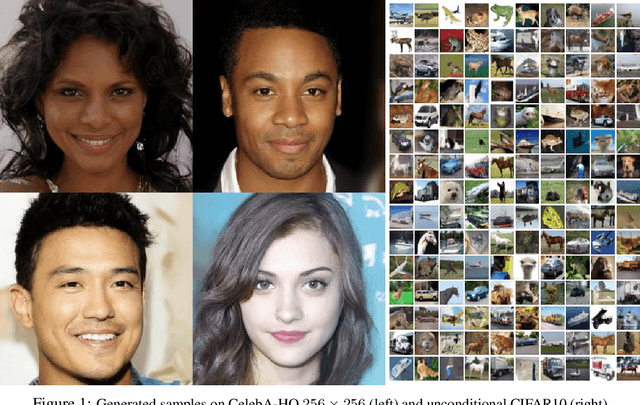

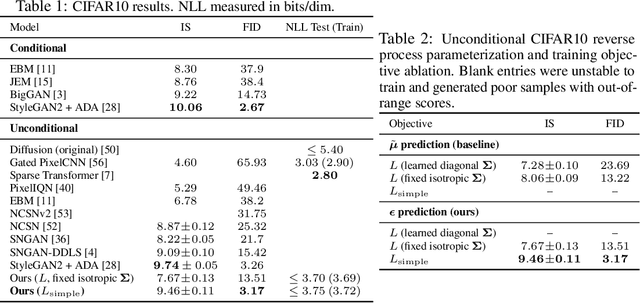
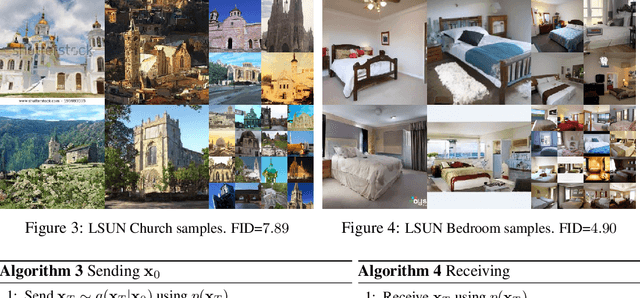
Abstract:We present high quality image synthesis results using diffusion probabilistic models, a class of latent variable models inspired by considerations from nonequilibrium thermodynamics. Our best results are obtained by training on a weighted variational bound designed according to a novel connection between diffusion probabilistic models and denoising score matching with Langevin dynamics, and our models naturally admit a progressive lossy decompression scheme that can be interpreted as a generalization of autoregressive decoding. On the unconditional CIFAR10 dataset, we obtain an Inception score of 9.46 and a state-of-the-art FID score of 3.17. On 256x256 LSUN, we obtain sample quality similar to ProgressiveGAN. Our implementation is available at https://github.com/hojonathanho/diffusion
Automatic Curriculum Learning through Value Disagreement
Jun 17, 2020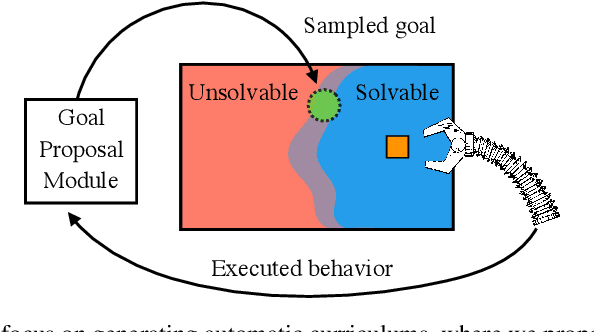


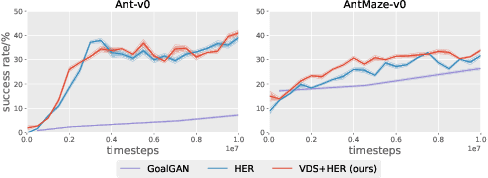
Abstract:Continually solving new, unsolved tasks is the key to learning diverse behaviors. Through reinforcement learning (RL), we have made massive strides towards solving tasks that have a single goal. However, in the multi-task domain, where an agent needs to reach multiple goals, the choice of training goals can largely affect sample efficiency. When biological agents learn, there is often an organized and meaningful order to which learning happens. Inspired by this, we propose setting up an automatic curriculum for goals that the agent needs to solve. Our key insight is that if we can sample goals at the frontier of the set of goals that an agent is able to reach, it will provide a significantly stronger learning signal compared to randomly sampled goals. To operationalize this idea, we introduce a goal proposal module that prioritizes goals that maximize the epistemic uncertainty of the Q-function of the policy. This simple technique samples goals that are neither too hard nor too easy for the agent to solve, hence enabling continual improvement. We evaluate our method across 13 multi-goal robotic tasks and 5 navigation tasks, and demonstrate performance gains over current state-of-the-art methods.
Mutual Information Maximization for Robust Plannable Representations
May 16, 2020
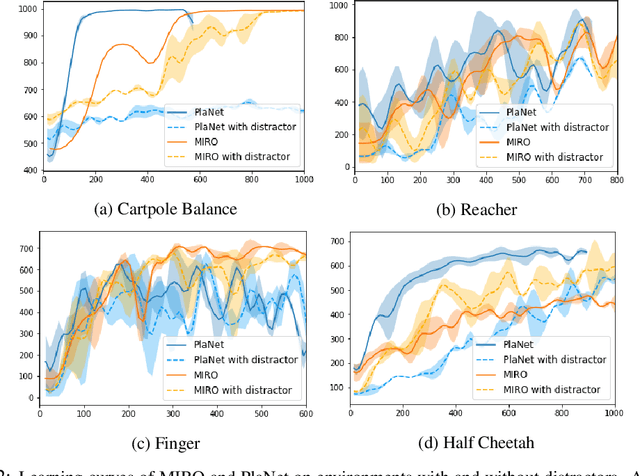
Abstract:Extending the capabilities of robotics to real-world complex, unstructured environments requires the need of developing better perception systems while maintaining low sample complexity. When dealing with high-dimensional state spaces, current methods are either model-free or model-based based on reconstruction objectives. The sample inefficiency of the former constitutes a major barrier for applying them to the real-world. The later, while they present low sample complexity, they learn latent spaces that need to reconstruct every single detail of the scene. In real environments, the task typically just represents a small fraction of the scene. Reconstruction objectives suffer in such scenarios as they capture all the unnecessary components. In this work, we present MIRO, an information theoretic representational learning algorithm for model-based reinforcement learning. We design a latent space that maximizes the mutual information with the future information while being able to capture all the information needed for planning. We show that our approach is more robust than reconstruction objectives in the presence of distractors and cluttered scenes
Model-Augmented Actor-Critic: Backpropagating through Paths
May 16, 2020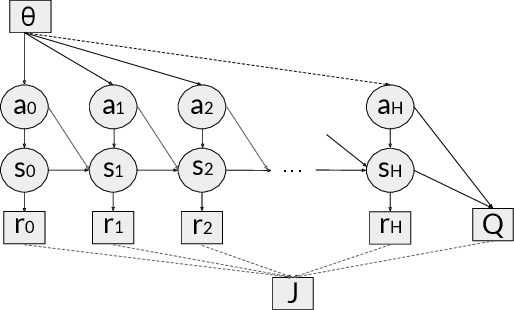

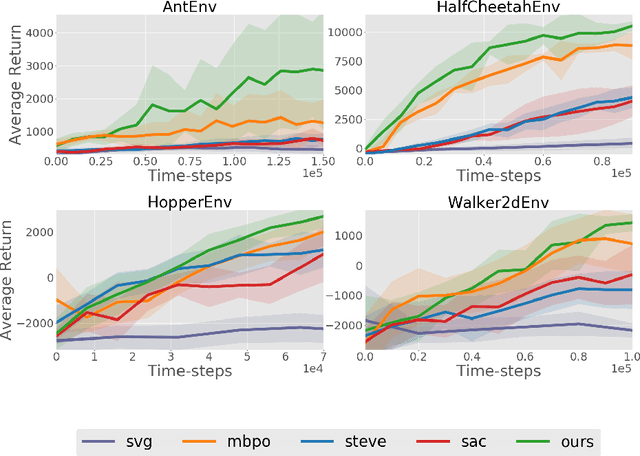

Abstract:Current model-based reinforcement learning approaches use the model simply as a learned black-box simulator to augment the data for policy optimization or value function learning. In this paper, we show how to make more effective use of the model by exploiting its differentiability. We construct a policy optimization algorithm that uses the pathwise derivative of the learned model and policy across future timesteps. Instabilities of learning across many timesteps are prevented by using a terminal value function, learning the policy in an actor-critic fashion. Furthermore, we present a derivation on the monotonic improvement of our objective in terms of the gradient error in the model and value function. We show that our approach (i) is consistently more sample efficient than existing state-of-the-art model-based algorithms, (ii) matches the asymptotic performance of model-free algorithms, and (iii) scales to long horizons, a regime where typically past model-based approaches have struggled.
Planning to Explore via Self-Supervised World Models
May 12, 2020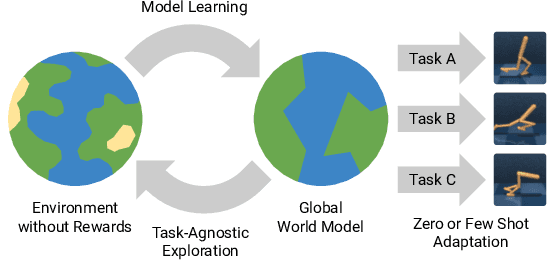
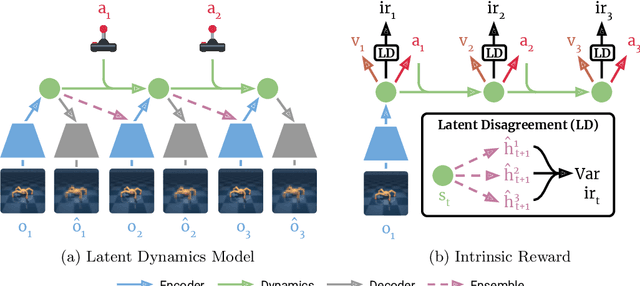
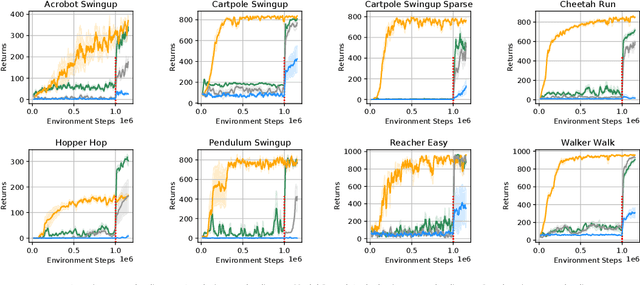

Abstract:Reinforcement learning allows solving complex tasks, however, the learning tends to be task-specific and the sample efficiency remains a challenge. We present Plan2Explore, a self-supervised reinforcement learning agent that tackles both these challenges through a new approach to self-supervised exploration and fast adaptation to new tasks, which need not be known during exploration. During exploration, unlike prior methods which retrospectively compute the novelty of observations after the agent has already reached them, our agent acts efficiently by leveraging planning to seek out expected future novelty. After exploration, the agent quickly adapts to multiple downstream tasks in a zero or a few-shot manner. We evaluate on challenging control tasks from high-dimensional image inputs. Without any training supervision or task-specific interaction, Plan2Explore outperforms prior self-supervised exploration methods, and in fact, almost matches the performances oracle which has access to rewards. Videos and code at https://ramanans1.github.io/plan2explore/
Reinforcement Learning with Augmented Data
May 11, 2020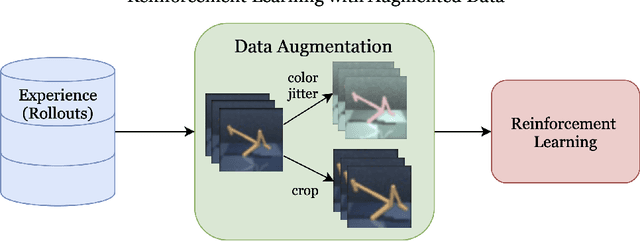
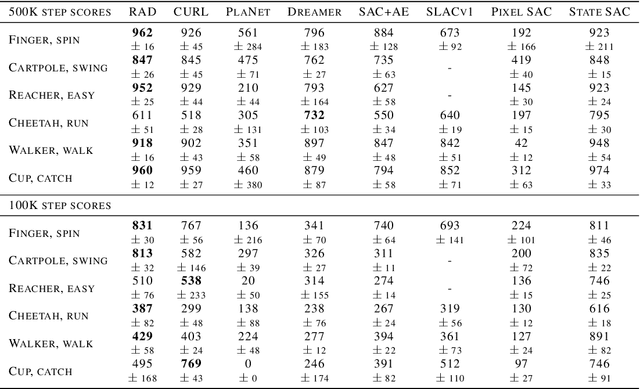
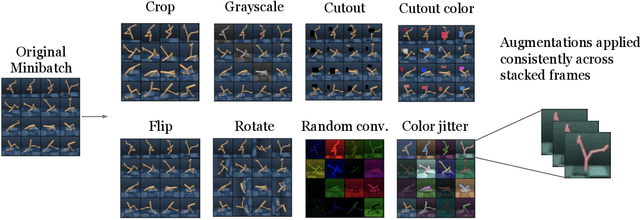
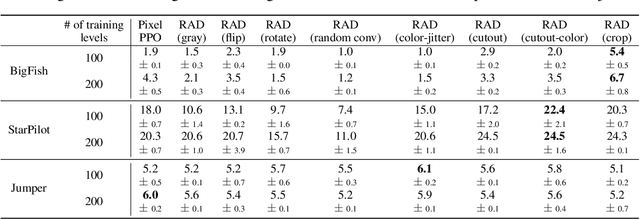
Abstract:Learning from visual observations is a fundamental yet challenging problem in reinforcement learning (RL). Although algorithmic advancements combined with convolutional neural networks have proved to be a recipe for success, current methods are still lacking on two fronts: (a) sample efficiency of learning and (b) generalization to new environments. To this end, we present RAD: Reinforcement Learning with Augmented Data, a simple plug-and-play module that can enhance any RL algorithm. We show that data augmentations such as random crop, color jitter, patch cutout, and random convolutions can enable simple RL algorithms to match and even outperform complex state-of-the-art methods across common benchmarks in terms of data-efficiency, generalization, and wall-clock speed. We find that data diversity alone can make agents focus on meaningful information from high-dimensional observations without any changes to the reinforcement learning method. On the DeepMind Control Suite, we show that RAD is state-of-the-art in terms of data-efficiency and performance across 15 environments. We further demonstrate that RAD can significantly improve the test-time generalization on several OpenAI ProcGen benchmarks. Finally, our customized data augmentation modules enable faster wall-clock speed compared to competing RL techniques. Our RAD module and training code are available at https://www.github.com/MishaLaskin/rad.
Plan2Vec: Unsupervised Representation Learning by Latent Plans
May 07, 2020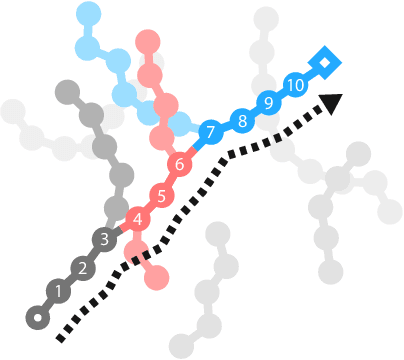
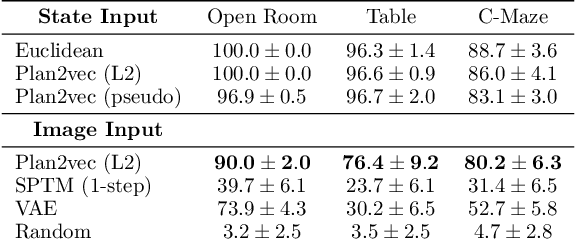
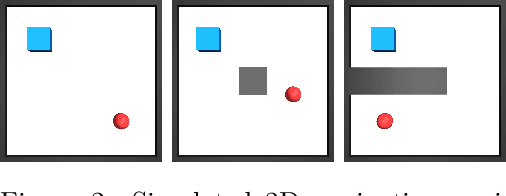

Abstract:In this paper we introduce plan2vec, an unsupervised representation learning approach that is inspired by reinforcement learning. Plan2vec constructs a weighted graph on an image dataset using near-neighbor distances, and then extrapolates this local metric to a global embedding by distilling path-integral over planned path. When applied to control, plan2vec offers a way to learn goal-conditioned value estimates that are accurate over long horizons that is both compute and sample efficient. We demonstrate the effectiveness of plan2vec on one simulated and two challenging real-world image datasets. Experimental results show that plan2vec successfully amortizes the planning cost, enabling reactive planning that is linear in memory and computation complexity rather than exhaustive over the entire state space.
* code available at https://geyang.github.io/plan2vec
CURL: Contrastive Unsupervised Representations for Reinforcement Learning
Apr 28, 2020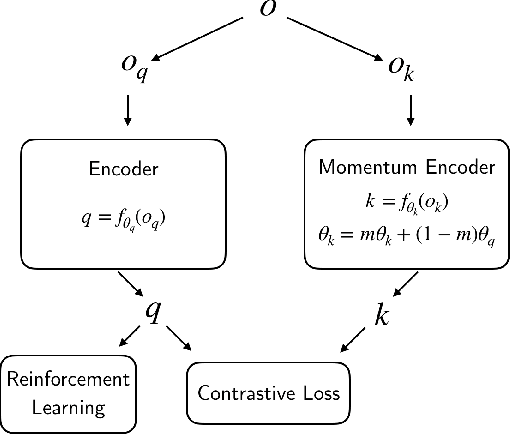
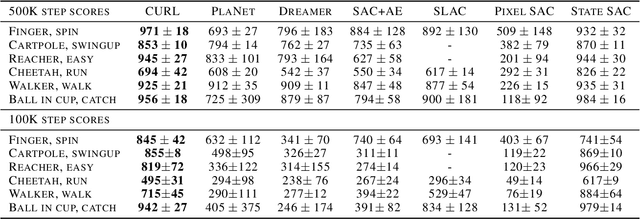
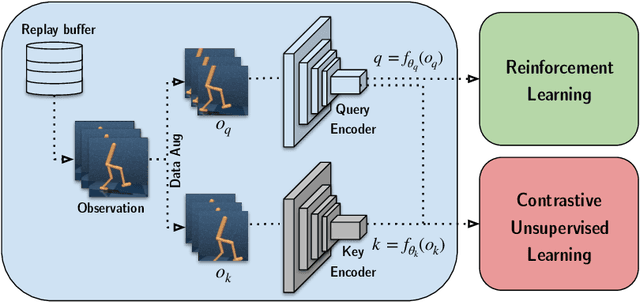
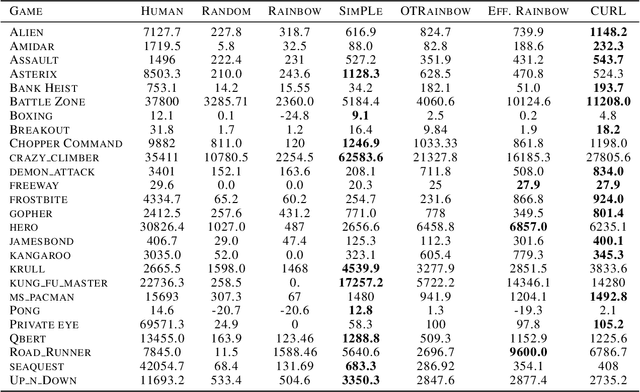
Abstract:We present CURL: Contrastive Unsupervised Representations for Reinforcement Learning. CURL extracts high-level features from raw pixels using contrastive learning and performs off-policy control on top of the extracted features. CURL outperforms prior pixel-based methods, both model-based and model-free, on complex tasks in the DeepMind Control Suite and Atari Games showing 1.9x and 1.6x performance gains at the 100K environment and interaction steps benchmarks respectively. On the DeepMind Control Suite, CURL is the first image-based algorithm to nearly match the sample-efficiency and performance of methods that use state-based features.
 Add to Chrome
Add to Chrome Add to Firefox
Add to Firefox Add to Edge
Add to Edge